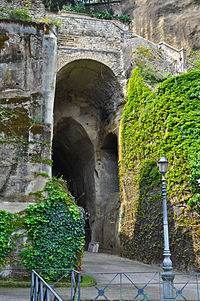- Crypta Neapolitana
-
The Crypta Neapolitana (Latin; "Neapolitan crypt") is an ancient Roman tunnel in Naples, Italy.
Geography
The tunnel passes beneath the Posillipo hill and connects Naples with the so-called Phlegrean Fields and, then, the town of Pozzuoli along the road known as the via Domiziana. The tunnel is over 700 meters long. The eastern entrance (that is, on the Naples side) is in the part of Naples known as Piedigrotta ("at the foot of the grotta"); the western end is in the area now called Fuorigrotta ("outside the grotta"). The Piedigrotta entrance is now enclosed within an archaeological park. The site is also noteworthy for the presence of the so-called Virgil's tomb, as well as the tomb of the Italian poet Giacomo Leopardi.
History
According to medieval legend, the tunnel was built by Virgil in a single night![1] In fact it was built under the direction of the Roman architect Lucius Cocceius Auctus during the civil war between Octavian and Sextus Pompeius ca.37 BCE. The tunnel is one of a number of such works in the Naples area built by Cocceius.
The tunnel was still in active use as late as the 19th century and shows extensive restoration done by the architects of the Bourbon dynasty of Naples of that period. It was superseded by two modern tunnels in the early 20th century. Today, it is under restoration as an archaeological site.
Notes and references
- ^ Lancaster, Jordan (2005), In the Shadow of Vesuvius: A Cultural History of Naples, I.B.Tauris, p. 48, ISBN 1850437645, http://books.google.com/?id=TnM1g0oKkN0C, retrieved 2008-04-30
Coordinates: 40°49′47″N 14°13′03″E / 40.829595°N 14.217550°E
Categories:- Roman roads in Naples
- Buildings and structures in Naples
- Italy road stubs
Wikimedia Foundation. 2010.

